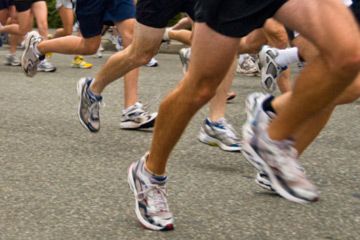Jumper's knee is another name for patellar tendonitis, which is inflammation in the tendon that connects the patella (kneecap) to the tibia (shinbone). This condition is often one of the most painful overuse injuries for recreational athletes.
What Causes Jumper's Knee?
The most common activity that causes jumper's knee is continuous jumping or running. Any repetitive motion such as aerobics, jogging, walking or bicycling may lead to jumper's knee. Each of these activities will put the patellar tendon at risk of becoming inflamed.
Advertisement
Jumper's knee can also occur in people who have problems with the way their hips, legs, knees or feet are aligned. A misalignment can result from having wide hips, bowlegs, knock-knees or flat feet. When this occurs, the patellar tendon may experience continuous stress during strenuous exercise, causing inflammation, tears or even a rupture.
Symptoms of Jumper's Knee Are:
- Pain with bending or straightening the leg;
- Pain that is worse in the evening or at night;
- Pain or tenderness behind the kneecap;
- Pain and tenderness around the patellar tendon;
- Swelling in the knee joint or swelling where the patellar tendon attaches to the shinbone;
- Pain with jumping, running or walking, especially downhill or downstairs; and
- Restricted movement in the area surrounding the injury.
How Can I Prevent Jumper's Knee?
Jumper's knee is an inflammation of the patellar tendon usually caused by overuse during activities such as jumping, running or biking uphill. Maintaining strong thigh muscles can be an effective way to prevent this condition. The following may also help prevent injury:
- Wear proper fitting shoes that are right for the activity;
- Use orthotics to support the arch if necessary; and
- Gently stretch before and after exercising.
How Is Jumper's Knee Diagnosed?
A health care provider will examine your knee to see if you have tenderness at the patellar tendon. They may have you run, jump or squat to see if this causes pain. Also, your feet should be examined to see if you have a problem with overpronation (fallen arch). In many cases an X-ray or MRI will be ordered for your knee.
Treatment for Jumper's Knee May Include:
- Apply ice to your knee for 20 minutes every 3 to 4 hours for 2 to 3 days or until the pain and swelling go away;
- Take an anti-inflammatory medication or a pain medication prescribed by your health care provider;
- Receive cortisone injections from your health care provider;
- Wear a band across the patellar tendon, called an infrapatellar strap, or a special knee brace (the strap or brace will support your patellar tendon, preventing it from becoming overused or more painful); and
- Wear custom-made arch supports called orthotics if you have a problem with overpronation.
The effects of patellar tendonitis may last weeks to months. How long it takes to recover depends on the severity of the condition and your willingness to apply treatments. However, not overusing the knee while treating jumper's knee may be the best remedy.
Advertisement
